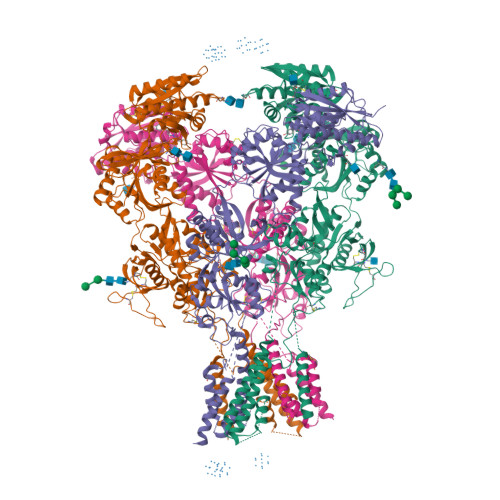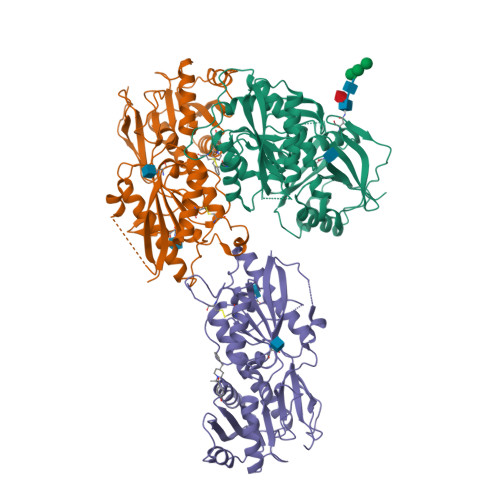
Top ▲

Gene and Protein Information  |
|||||||
| Species | TM | P Loops | AA | Chromosomal Location | Gene Symbol | Gene Name | Reference |
| Human | 3 | 1 | 938 | 9q34.3 | GRIN1 | glutamate ionotropic receptor NMDA type subunit 1 | |
| Mouse | 3 | 1 | 938 | 2 17.14 cM | Grin1 | glutamate receptor, ionotropic, NMDA1 (zeta 1) | |
| Rat | 3 | 1 | 938 | 3p13 | Grin1 | glutamate ionotropic receptor NMDA type subunit 1 | |
Previous and Unofficial Names  |
| NMDAR1 | GluRzeta1 | NMDA-R1 | glutamate receptor, ionotropic, NMDA1 (zeta 1) | glutamate receptor |
Database Links  |
|
| Alphafold | Q05586 (Hs), P35438 (Mm), P35439 (Rn) |
| ChEMBL Target | CHEMBL2015 (Hs), CHEMBL3885583 (Mm), CHEMBL330 (Rn) |
| DrugBank Target | Q05586 (Hs), Q05586 (Hs) |
| Ensembl Gene | ENSG00000176884 (Hs), ENSMUSG00000026959 (Mm), ENSRNOG00000011726 (Rn) |
| Entrez Gene | 2902 (Hs), 14810 (Mm), 24408 (Rn) |
| Human Protein Atlas | ENSG00000176884 (Hs) |
| KEGG Gene | hsa:2902 (Hs), mmu:14810 (Mm), rno:24408 (Rn) |
| OMIM | 138249 (Hs) |
| Orphanet | ORPHA282786 (Hs) |
| Pharos | Q05586 (Hs) |
| RefSeq Nucleotide | NM_007327 (Hs), NM_008169 (Mm), NM_017010 (Rn) |
| RefSeq Protein | NP_015566 (Hs), NP_032195 (Mm), NP_058706 (Rn) |
| UniProtKB | Q05586 (Hs), P35438 (Mm), P35439 (Rn) |
| Wikipedia | GRIN1 (Hs) |
Selected 3D Structures  |
|||||||||||||

|
|
||||||||||||

|
|
||||||||||||
Natural/Endogenous Ligands  |
| D-aspartic acid |
| D-serine |
| glycine |
| L-aspartic acid |
| L-glutamic acid |
Download all structure-activity data for this target as a CSV file 
| Agonists | |||||||||||||||||||||||||||||||||||||||||||||||||||||||||||||||||||||||||||||||||||||||||||||||||||||||||||||||||||||||||||||||||||||||||||||||||||||||||||||||||||||||||||||||||||||||||||||||||||||||||||||||||||||||||||||||||||||||||||||||||||||||||||||||||||||||||||||||||||||||||||||||||||||||||||||||||||
| Key to terms and symbols | View all chemical structures | Click column headers to sort | |||||||||||||||||||||||||||||||||||||||||||||||||||||||||||||||||||||||||||||||||||||||||||||||||||||||||||||||||||||||||||||||||||||||||||||||||||||||||||||||||||||||||||||||||||||||||||||||||||||||||||||||||||||||||||||||||||||||||||||||||||||||||||||||||||||||||||||||||||||||||||||||||||||||||||||||||
|
|||||||||||||||||||||||||||||||||||||||||||||||||||||||||||||||||||||||||||||||||||||||||||||||||||||||||||||||||||||||||||||||||||||||||||||||||||||||||||||||||||||||||||||||||||||||||||||||||||||||||||||||||||||||||||||||||||||||||||||||||||||||||||||||||||||||||||||||||||||||||||||||||||||||||||||||||||
| Antagonists | |||||||||||||||||||||||||||||||||||||||||||||||||||||||||||||||||||||||||||||||||||||||||||||||||||||||||||||||||||||||||||||||||||||||||||||||||||||||||||||||||||||||||||||||||||||||||||||||||||||||||||||||||||||||||||||||||||||||||||||||||||||||||||||||||||||||||||||||||||||||||||||||||||||||||||||||||||||||||||||||||||||||||||||||||||||||||||||||||||||||||||||||||||||||||||||||||||||||||||||||||||
| Key to terms and symbols | View all chemical structures | Click column headers to sort | |||||||||||||||||||||||||||||||||||||||||||||||||||||||||||||||||||||||||||||||||||||||||||||||||||||||||||||||||||||||||||||||||||||||||||||||||||||||||||||||||||||||||||||||||||||||||||||||||||||||||||||||||||||||||||||||||||||||||||||||||||||||||||||||||||||||||||||||||||||||||||||||||||||||||||||||||||||||||||||||||||||||||||||||||||||||||||||||||||||||||||||||||||||||||||||||||||||||||||||||||
|
|||||||||||||||||||||||||||||||||||||||||||||||||||||||||||||||||||||||||||||||||||||||||||||||||||||||||||||||||||||||||||||||||||||||||||||||||||||||||||||||||||||||||||||||||||||||||||||||||||||||||||||||||||||||||||||||||||||||||||||||||||||||||||||||||||||||||||||||||||||||||||||||||||||||||||||||||||||||||||||||||||||||||||||||||||||||||||||||||||||||||||||||||||||||||||||||||||||||||||||||||||
| View species-specific antagonist tables | |||||||||||||||||||||||||||||||||||||||||||||||||||||||||||||||||||||||||||||||||||||||||||||||||||||||||||||||||||||||||||||||||||||||||||||||||||||||||||||||||||||||||||||||||||||||||||||||||||||||||||||||||||||||||||||||||||||||||||||||||||||||||||||||||||||||||||||||||||||||||||||||||||||||||||||||||||||||||||||||||||||||||||||||||||||||||||||||||||||||||||||||||||||||||||||||||||||||||||||||||||
| Antagonist Comments | |||||||||||||||||||||||||||||||||||||||||||||||||||||||||||||||||||||||||||||||||||||||||||||||||||||||||||||||||||||||||||||||||||||||||||||||||||||||||||||||||||||||||||||||||||||||||||||||||||||||||||||||||||||||||||||||||||||||||||||||||||||||||||||||||||||||||||||||||||||||||||||||||||||||||||||||||||||||||||||||||||||||||||||||||||||||||||||||||||||||||||||||||||||||||||||||||||||||||||||||||||
| GV196771A has two binding sites on rat GluN1 subunits expressed in HEK293 cells. The low affinity site has a Ki value of 121-153 nM depending on the splice variant tested [2]. | |||||||||||||||||||||||||||||||||||||||||||||||||||||||||||||||||||||||||||||||||||||||||||||||||||||||||||||||||||||||||||||||||||||||||||||||||||||||||||||||||||||||||||||||||||||||||||||||||||||||||||||||||||||||||||||||||||||||||||||||||||||||||||||||||||||||||||||||||||||||||||||||||||||||||||||||||||||||||||||||||||||||||||||||||||||||||||||||||||||||||||||||||||||||||||||||||||||||||||||||||||
| Immunopharmacology Comments |
| Autoantibodies that target GluN1 cause anti-NMDA receptor encephalitis [8,11,14]. Approximately 50% of cases occur in the presence ovarian teratoma. The condition can manifest postviral infection [12], but many cases are idiopathic [7]. Anti-NMDA receptor encephalitis has been identified in a non-human mammal [13], and fulminant disease can be induced in a mouse model by active immunisation with conformationally stabilised, native-like NMDA holoreceptors (GluN1-GluN2B tetramers embedded in liposomes) [4]. |
Clinically-Relevant Mutations and Pathophysiology 
|
||||||||||||||
|
||||||||||||||
1. Chazot PL, Reiss C, Chopra B, Stephenson FA. (1998) [3H]MDL 105,519 binds with equal high affinity to both assembled and unassembled NR1 subunits of the NMDA receptor. Eur J Pharmacol, 353 (1): 137-40. [PMID:9721050]
2. Chopra B, Chazot PL, Stephenson FA. (2000) Characterization of the binding of two novel glycine site antagonists to cloned NMDA receptors: evidence for two pharmacological classes of antagonists. Br J Pharmacol, 130 (1): 65-72. [PMID:10780999]
3. Deur C, Agrawal AK, Baum H, Booth J, Bove S, Brieland J, Bunker A, Connolly C, Cornicelli J, Dumin J et al.. (2007) N-(6,7-dichloro-2,3-dioxo-1,2,3,4-tetrahydroquinoxalin-5-yl)-N-alkylsulfonamides as peripherally restricted N-methyl-D-aspartate receptor antagonists for the treatment of pain. Bioorg Med Chem Lett, 17 (16): 4599-603. [PMID:17562362]
4. Jones BE, Tovar KR, Goehring A, Jalali-Yazdi F, Okada NJ, Gouaux E, Westbrook GL. (2019) Autoimmune receptor encephalitis in mice induced by active immunization with conformationally stabilized holoreceptors. Sci Transl Med, 11 (500). DOI: 10.1126/scitranslmed.aaw0044 [PMID:31292262]
5. Karakas E, Furukawa H. (2014) Crystal structure of a heterotetrameric NMDA receptor ion channel. Science, 344 (6187): 992-7. [PMID:24876489]
6. Karakas E, Simorowski N, Furukawa H. (2011) Subunit arrangement and phenylethanolamine binding in GluN1/GluN2B NMDA receptors. Nature, 475 (7355): 249-53. [PMID:21677647]
7. Kayser MS, Dalmau J. (2016) Anti-NMDA receptor encephalitis, autoimmunity, and psychosis. Schizophr Res, 176 (1): 36-40. [PMID:25458857]
8. Kelleher E, Barry H, Cotter DR, Corvin A, Murphy KC. (2020) Autoantibodies and Psychosis. Curr Top Behav Neurosci, 44: 85-123. [PMID:31292938]
9. Kulagowski JJ, Baker R, Curtis NR, Leeson PD, Mawer IM, Moseley AM, Ridgill MP, Rowley M, Stansfield I, Foster AC et al.. (1994) 3'-(Arylmethyl)- and 3'-(aryloxy)-3-phenyl-4-hydroxyquinolin-2(1H)-ones: orally active antagonists of the glycine site on the NMDA receptor. J Med Chem, 37 (10): 1402-5. [PMID:8182696]
10. Leeson PD, Carling RW, Moore KW, Moseley AM, Smith JD, Stevenson G, Chan T, Baker R, Foster AC, Grimwood S et al.. (1992) 4-Amido-2-carboxytetrahydroquinolines. Structure-activity relationships for antagonism at the glycine site of the NMDA receptor. J Med Chem, 35 (11): 1954-68. [PMID:1534584]
11. Newman MP, Blum S, Wong RC, Scott JG, Prain K, Wilson RJ, Gillis D. (2016) Autoimmune encephalitis. Intern Med J, 46 (2): 148-57. [PMID:26899887]
12. Prüss H. (2017) Postviral autoimmune encephalitis: manifestations in children and adults. Curr Opin Neurol, 30 (3): 327-333. [PMID:28234798]
13. Prüss H, Leubner J, Wenke NK, Czirják GÁ, Szentiks CA, Greenwood AD. (2015) Anti-NMDA Receptor Encephalitis in the Polar Bear (Ursus maritimus) Knut. Sci Rep, 5: 12805. [PMID:26313569]
14. Venkatesan A, Adatia K. (2017) Anti-NMDA-Receptor Encephalitis: From Bench to Clinic. ACS Chem Neurosci, 8 (12): 2586-2595. [PMID:29077387]